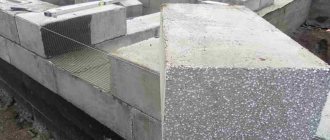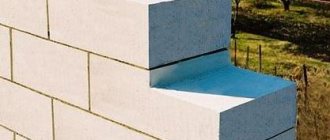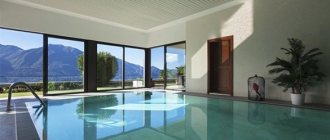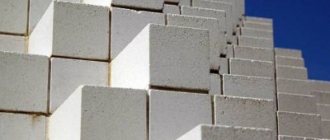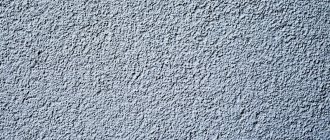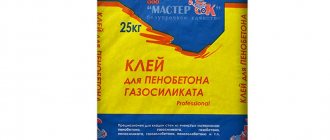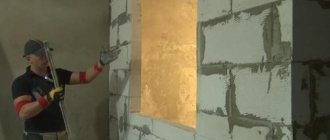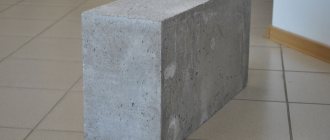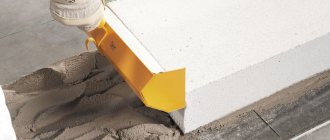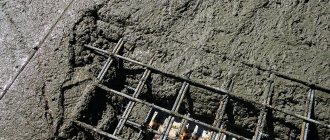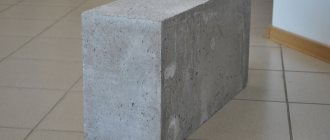When choosing a building material for building a house, it is necessary to follow the technology, know the nuances and features of the application, as well as the intricacies of the construction process itself. This applies to any type of material, but it is especially true for modern ones, which often have unique properties and characteristics.
For example, if masonry mesh is not used for the foam block, then the reliability, strength and durability of the structure made from this material will noticeably suffer.
In the photo there is a wall made of foam block.
Foam block house foundation
Foam blocks are widely used in construction, which are characterized by excellent thermal conductivity, sound insulation and other characteristics. It is quite possible to build a country house from this material during the construction season.
Laying foam blocks in winter is allowed, but subject to certain conditions:
- the foundation for a house made of foam blocks must be erected before the onset of frost to avoid deformation of the structure;
- use adhesive solutions for foam blocks with special additives and plasticizers, which can be used at sub-zero temperatures, usually not lower.
Attention! Even when using plasticizers, construction with foam blocks should not be carried out at temperatures below -10ºС. In severe frosts, you can build a heated tent over the construction site, if the area is small.
Laying a foundation for any building is a very important and responsible moment, and regarding a house made of foam blocks, it must be strong and reliable, not subject to deformation, but not necessarily powerful or deep.
The best option is to install a monolithic strip foundation or, alternatively, to pour a reinforced concrete slab as the foundation of the house. A foundation made of concrete blocks is also allowed, but it must be reinforced with a monolithic reinforced concrete belt .
Common difficulties and mistakes faced by novice builders
When working with foam concrete structural units, difficulties may arise not only for novice craftsmen, but also for more experienced builders. The difficulties and mistakes are as follows:
- Work with the material in the cold or during rain (in conditions of increased dampness). These factors can affect the quality of the rows, and even lead to cracks in the products and poor adhesion between the elements.
- Too much or too little solution at the joints. This leads to unevenness of the next layer of masonry, reduces the heat inside the building and reduces the reliability of the entire structure.
- Before placing the foam blocks on the glue, the products are not cleaned of dirt. Cleaning must be done, and sometimes the elements must be impregnated with a primer.
- Little attention is paid to the front row. At the stage of laying blocks on the foundation, you need to try as hard as possible to make everything smooth. If you didn’t manage to lay it correctly the first time, it’s better to redo the masonry.
- You can correct foam concrete products only during the first 10-12 minutes. Then the mixture begins to set and the blocks can no longer be moved.
- Door and window openings must be reinforced. Otherwise, the design will be unreliable.
- The adhesive composition is mixed in too much volume. There is no need to do this. The solution must be prepared in portions so that it does not spoil.
You can start plastering the walls of the house only after 30 days, because the building will shrink a little in the first month.
By following these recommendations and avoiding common mistakes, you will be able to avoid further problems with the operation of the building and build a reliable structure.
Features of the first row of masonry
Photo of the first row.
To perform masonry in order to preserve the thermal conductivity properties of the material, a special masonry mixture for foam blocks is used, and for the first row it is recommended to use cement mortars for a stronger, more reliable connection with the foundation structure.
As a rule, laying begins from the highest corner, and it is necessary to level the structure from the very first row. It will not work to do this with adhesive solutions - the maximum thickness of the seam cannot exceed 5-8 mm, and 30 mm may be needed to level the first row.
Therefore, it is better to lay the first row on a regular solution. But even with this, the consumption of cement for laying foam blocks is small.
Rules for dressing rows of masonry
Typically, laying foam blocks in two rows is done for external walls that require the use of block ligation, which comes in several types:
- row dressing with offset;
- tying method - through three rows of masonry, one tying is performed;
- a multilayer method, which is characterized by the fact that the laying of foam blocks in two rows is carried out using a flexible connection, when the untied layers of foam blocks are reinforced with metal rods and meshes.
About foam concrete blocks
Choosing the material from which future housing will be built is not the easiest task. The length and width of standard blocks made of porous concrete are 60x30 centimeters, and the thickness is 20 centimeters.
But these sizes are not the only options for structural units. If necessary, products of other dimensions can be found on the construction market.
Before purchasing material, it is important to pay attention to the following nuance:
- the blocks should not have cracks, chips or other defects;
- the shape of structural units made of foam concrete must be correct;
- the structure of the material must be homogeneous.
The surface of the foam block, which has standard dimensions, must be flat on the bottom, top and sides. If the dimensions of the product are larger than 60x30x20, then they may have holes and voids that make working with them easier. Thanks to various side pockets and grooves, holding and placing a volumetric element in your hands becomes much easier, and less effort and energy is spent on the process.
In addition to standard blocks, U-shaped products must also be used to strengthen the structure.
A building material such as foam concrete has certain characteristics. These include: service life, ease of installation, relatively small mass of foam concrete products, fire safety, warmth, noise insulation and environmental friendliness.
There are several types of blocks made from this material. They are divided into:
- thermal insulation , used when an insulated version of the building is needed;
- structural , able to withstand additional load;
- thermal insulation and structural, combine the properties of the first and second types.
Why is reinforcement necessary and how to make it
Photo of reinforcement.
When building houses from foam blocks, it is necessary to reinforce the masonry in order to give the structure greater strength and avoid the formation of cracks. Reinforcement is the use of metal rods or wire between horizontal joints.
If a cement mixture is used, then the reinforcement is located between the blocks, since the level is leveled with mortar, and the calculation of masonry from foam blocks in this case should also take into account the width of the seam. The situation is different in the case of using adhesive compositions - the reinforcement is placed in special grooves.
Attention! Before installing the floors, a reinforced armored belt must be installed. Sometimes it can be made of brick. But in any case, it must be additionally insulated.
Reinforcement using masonry mesh
In order to give reliability and greater strength to the structure, masonry mesh for foam blocks is often used, which, for ease of transportation and use, is produced in rolls with or without anti-corrosion treatment. Mesh is laid in the seams to provide additional stability to the building structure
In the video presented in this article you will find additional information on this topic.
Approximate costs for working independently
If you plan to build a house from foam concrete blocks, then you need to make some important calculations. It is necessary to determine approximately how much material will be needed, draw up a building design and do many other important things. Initial information for self-construction looks like this:
- length, width, height of one product – 60x30x20 (in centimeters);
- dimensions and number of openings (this data is noted in the construction project documents);
- the contour and height of the structure - according to the plan;
- the thickness of walls made of foam concrete products is determined at the initial stage (design).
Computational operations can be carried out in several ways. Usually choose one of two methods:
- Using a calculator (online). Such a system allows you to perform accurate calculations and takes into account all the nuances.
- Without equipment, on your own. If you know the exact dimensions of the foam concrete elements, the design and the final design plan, then you can calculate how much material will be needed to work.
The manual method needs to be discussed in more detail. It is carried out according to the following scheme:
- The lengths of the walls are added up, which allows you to find out the perimeter of the future building.
- The length of the contour and the height of the walls are multiplied, thereby determining the wall area.
- The total parameters of all doors and windows are calculated.
- The resulting value is subtracted from the dimensions of the entire structure.
- The last step is to divide the resulting area by the area of the foam concrete products (their side part).
What is needed to build a house from foam blocks on your own?
The photo shows the processing of foam blocks.
If the construction of a house is carried out with the involvement of a construction team, they bring all the necessary equipment and tools with them.
But if the work is carried out independently, you need to prepare some equipment:
- container for preparing cement mortar or adhesive mixture;
- shovel;
- buckets;
- drill attachment for mixing the solution and drill;
- level;
- rubber hammer;
- hacksaw or saw for cutting blocks;
- corner for cutting;
- trowel for applying the solution;
- serrated trowel;
- film for covering masonry;
- grater for leveling,
- A constant source of water should also be provided at the construction site.
Basic rules for laying foam blocks and sequence of work
Photo – finished foam block masonry.
If you still decide to build a house yourself, it would be useful to familiarize yourself with how to do masonry correctly, as well as determine the order and sequence of the main stages of construction.
- Material selection:
- for a beginner, it is recommended to use adhesive compounds, since with their help it is easier to perform even laying, unlike cement mortar, which requires some experience to work with;
- An adhesive solution is prepared based on a dry mixture with the addition of water. For stirring, it is convenient to use a special mixing attachment on a drill;
- When preparing the solution, it should be taken into account that it must be used within a maximum of 20 minutes.
- Leveling corners and installing beacon blocks:
- a mooring cord should be secured at a distance of 2 mm from the side edge;
- place blocks underneath it along the perimeter at a certain distance from each other to avoid sagging;
- When rearranging the cord for a new row, it is tied to nails specially fixed in the seam of the masonry.
- Marking the building:
- window/door openings;
- places where internal partitions adjoin load-bearing walls;
- preparing, using a marking square and a hacksaw or saw, products of the required sizes for dressing the masonry and for intersections.
- Work should be carried out at temperatures from 5 to 25 ºС; at sub-zero temperatures it is necessary to use frost-resistant mixture compositions.
- Clearly and accurately observe the rows and graft the dressings of the rows.
- After laying the next row, it should be cleaned of splinters, dust and all unevenness should be removed using a construction float.
- The glue should be applied with a notched trowel.
- Be sure to follow the dressing rules, the classic version with an offset of half a block of the next row.
- Control of masonry accuracy:
- corners are checked with a wooden corner;
- the horizontal level is determined by the rule and the level;
- the verticality of the structure is controlled by plumb and level;
- detected excesses of the permissible error are corrected either with a plane or during the execution of the next row;
- after 2-4 rows, a level is used to determine how smooth the masonry is, and with a tape measure it is necessary to measure the length of the walls.
Photo - reinforcement of openings.
Expert advice on choosing and laying the mixture
The masonry mixture is very important during construction work; the strength and technical characteristics of the constructed building depend on it.
When making a choice, it is worth taking into account the opinion of experts in this field; they know better how to correctly place foam blocks on the solution and what to pay attention to when removing them when purchasing.
- The materials used must be of only high quality. Lower quality cement has a negative impact on the strength of the mortar.
- Ready-made adhesive mixtures should be stored in a dry place; it is better to choose materials from a well-known brand. This guarantees the correct preparation of mixtures and proper storage conditions for finished products.
- It is important to carefully monitor the proportions of materials when mixing the solution and follow all instructions;
- When making your own solution, you should use special additives and components that increase the strength and elasticity of the material.
- For non-residential premises - garages, fences, outbuildings, and others where thermal conductivity is not of great importance, it is better to take cement mortar - this will save cash. For residential premises, the best option would be a ready-made adhesive mixture
It’s up to you to decide what is best to lay foam blocks on; cement mortar and a specialized adhesive mixture are similar to each other. They have a large list of advantages, but not many disadvantages. Their main difference is the cost and thickness of the seam between the blocks.
There are no special requirements for the level of skill, the work can be easily completed by any person, the main thing is to follow the instructions and recommendations when choosing the material and its preparation.
A few words about finishing
Finished walls can be plastered from the inside with tile adhesive or the same one you used for masonry. The layer of plaster in this case should be 5-7 millimeters. During the finishing process, it is necessary to glue the reinforcing mesh. Therefore, the glue is applied to the surface in two layers - a mesh is glued to the first fresh layer, and after it dries, a second, leveling layer is applied.
In most cases, it makes no sense to use plasterboard and other sheet materials for finishing, since the walls of their aerated blocks are smooth. Absolutely any materials can be used as a finishing coating - wallpaper, tiles, decorative plaster, plastic panels, etc.
As for exterior finishing, the best option is siding with preliminary insulation with mineral wool using the “ventilated facade” technology. You can learn more about the process of finishing foam concrete from other articles on our portal.
Why glue and not mortar have the benefits of a thin seam?
Plastering walls made of aerated concrete, interior and exterior decoration of the facade of a house made of aerated concrete blocks, how and how to plaster an aerated concrete block with your own hands, photo-video and price
First of all, I note that glue can only be used for autoclave blocks that have precise geometry. It is not worth using glue for non-autoclaved foam concrete, since it cannot be applied in a thick layer, and when applied thinly, cracks will form.
As for the autoclaved aerated concrete or gas silicate block, the use of a special adhesive solution when laying it provides a number of advantages:
Thin seams make the wall stronger and warmer
- Strengthening. The seams in any masonry are the least durable areas of the wall. Therefore, reducing the thickness of the seam increases its load-bearing capacity;
- Good adhesion. The glue has better adhesion to the blocks than regular mortar. This also improves the strength of the masonry;
- Increases the speed of wall construction. During the process of building walls, you have to be distracted much less often by preparing the mortar. In addition, the glue is applied faster than the solution;
The use of glue increases the speed of masonry
The only downside is that the glue can only be applied in a thin layer. As I already said, this limits its scope. In particular, glue is not usually used for the first row of blocks.
Adhesive for foam blocks: varieties, temperature of use and consumption
Each building material has specific features, taking into account which they are used in certain works on the construction of buildings and structures. In addition, taking into account the existing characteristics, a composition is selected for each product that can provide reliable fixation. Among the available range of materials, it is worth highlighting foam blocks, which also require a high-quality adhesive composition.
Advantages and disadvantages
When choosing an easy-to-install and high-quality building material for the construction of walls, experts are increasingly giving preference to foam concrete blocks. However, the positive features of the products can be appreciated only when they are laid not on ordinary cement mortar, but when using special glue. This composition is distinguished by its viscosity, sets more effectively, and does not shrink after hardening; in addition, the blocks, which are distinguished by their porous structure, do not absorb moisture from it, due to which it is considered better than cement mortar. The products are in demand in the construction of new buildings, as well as in the reconstruction and modernization of old buildings. Both residential buildings and country houses, baths and saunas are erected from blocks. The material can be used not only for laying load-bearing walls, but also as a product for installing partitions, as well as raw materials for performing work to ensure thermal and sound insulation of buildings.
As for glue for foam blocks, it is necessary to highlight the following main advantages of its use:
- since the seam formed by the adhesive composition is thinner than the layer of cement mortar, the appearance of “cold bridges” between structural elements is practically eliminated;
- the consumption of the composition also depends on the small thickness of the layer, which will be less in comparison with other compositions;
- due to the need for less substance for work, the time for preparing the mixture can be significantly reduced, which also reduces labor costs;
- diluting the composition does not require the use of special devices for mixing the material; a conventional drill is suitable for preparatory work with glue;
- the specific properties of the product have a positive effect on the sound-proofing and heat-insulating properties of the building material;
- good plasticity of the mixture makes it possible to adjust the laying of blocks;
- the adhesive composition is moisture-resistant, so the likelihood of microorganisms forming on the base is excluded;
- due to the minimal thickness of the connecting seam, there is no need for additional processing of the base for leveling, which makes it possible to reduce costs associated with finishing work on walls and partitions;
- the mixture is sold in small bags, due to which the products can be transported in ordinary passenger vehicles without using trucks;
- All components of the glue are completely safe for humans and the environment.
In addition to positive qualities, such compositions have the following disadvantages:
- the products are highly expensive, due to which they are used mainly for the construction of small buildings, however, by adhering to the recommendations for dilution of the composition, it is possible to achieve rational use of the products, which will not significantly affect costs;
- It is not possible to visually determine the quality of the mixture.
To reduce the risk of purchasing goods that will have low quality characteristics, it is necessary to focus on the following nuances:
- to carry out installation work in winter at sub-zero temperatures, you should buy glue that contains special frost-resistant additives that affect the properties of the entire mixture;
- experts recommend not to rush to purchase recently released material; it is better to opt for a composition with a later date of manufacture;
- products from little-known brands should not be considered for work, since there is a risk that the product is of poor quality; products of popular and well-known brands rarely have low performance characteristics, with the exception of counterfeits of this brand;
- When calculating the required amount of mixture required for work, some errors should be taken into account, which in any case may arise during the laying of foam blocks, so it is better to have at least one extra bag of glue in stock.
Additional materials
High-quality laying of foam blocks involves the use of the following materials:
- masonry mortar;
- reinforcing mesh;
- reinforcing steel bar;
- waterproofing agents.
Masonry solutions
Above the first row for laying foam concrete, a ready-made polymer-cement mixture is used, sold in paper bags, packaged 25 kg.
Above the first row, ready-made polymer-cement mixture is used for laying foam concrete, sold in paper bags, packaged 25 kg. To prepare a working solution (construction adhesive), just mix the mixture with water in the proportions indicated on the package with a hand-held construction mixer.
Important. For laying foam blocks, it is necessary to use only special glue intended for these purposes. It is incorrect to use polymer-cement mixtures for other purposes (for installing tiles, polystyrene slabs, basalt insulation mats, etc.).
To lay the first row of foam concrete, you will need a classic cement-sand mortar in a ratio of 1:3. Often, a lime version of the mortar is used for this, when a third part (by volume) of slaked lime (paste) is added to the cement-sand mixture.
Reinforcing materials
Foam concrete has good compressive strength, but its fracture and tensile strength characteristics require additional reinforcement
Foam concrete has good compressive strength, but its fracture and tensile strength characteristics require additional reinforcement. For this purpose, reinforcing masonry mesh and reinforcing steel rods are used. They are not mounted continuously. Fiberglass mesh should be laid between the blocks in 3-4 rows, and steel reinforcement (rods with a diameter of 8-10 mm are used) in places of greatest load (corners, openings). If it is necessary to construct a reinforcing belt, you will additionally need steel reinforcement and tying wire to create a continuous reinforcing structure.
Waterproofing
Waterproofing materials are needed to create a moisture barrier between the foundation (basement) and the first row of foam concrete
Waterproofing materials are needed to create a moisture barrier between the foundation (basement) and the first row of foam concrete. Considering the porosity of wall building materials and the ability to actively absorb moisture, in this case there are increased requirements for waterproofing. Double protection is usually used - first a layer of bitumen mastic on the surface of the base, then 2-3 layers of rolled waterproofing material (roofing felt, waterproofing material, etc.)
